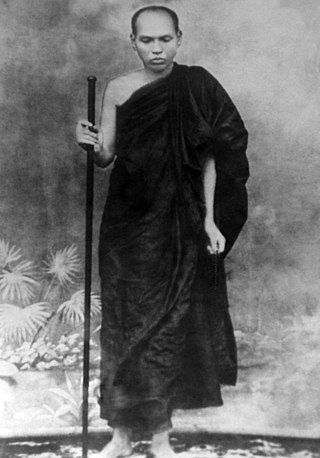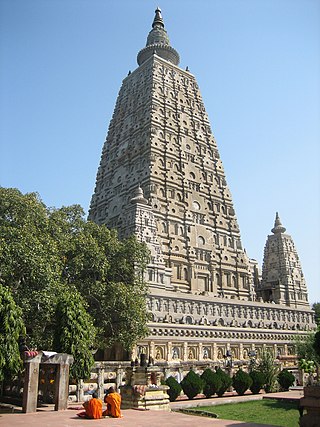Theravāda is the most commonly accepted name of Buddhism's oldest existing school. The school's adherents, termed Theravādins, have preserved their version of Gautama Buddha's teaching or Buddha Dhamma in the Pāli Canon for over two millennia.

Ledi Sayadaw U Ñaṇadhaja was an influential Theravada Buddhist monk. He was recognized from a young age as being developed in both the theory (Abhidhamma) and practice of Buddhism and so was revered as being scholarly. He wrote many books on Dhamma in Burmese and these were accessible even to a serious lay person, hence he was responsible for spreading Dhamma to all levels of society and reviving the traditional practice of Vipassanā meditation, making it more available for renunciates and lay people alike.

Satya Narayana Goenka was an Indian teacher of Vipassanā meditation. Born in Burma to an Indian business family, he moved to India in 1969 and started teaching meditation. His teaching emphasized that the Buddha's path to liberation was non-sectarian, universal, and scientific in character. He became an influential teacher and played an important role in establishing non-commercial Vipassana meditation centers globally. He was awarded the Padma Bhushan by the Government of India in 2012, an award given for distinguished service of high order.
Sayagyi U Ba Khin was the first Accountant General of the Union of Burma. He was the founder of the International Meditation Centre in Yangon, Myanmar and is principally known as a leading twentieth century authority on Vipassana meditation.
The Vipassanā movement, also called the Insight Meditation Movement and American Vipassana movement, refers to a branch of modern Burmese Theravāda Buddhism that promotes "bare insight" (sukha-Vipassana) to attain stream entry and preserve the Buddhist teachings, which gained widespread popularity since the 1950s, and to its western derivatives which have been popularised since the 1970s, giving rise to the more dhyana-oriented mindfulness movement.
The Buddhist Publication Society (BPS) is a publishing house with charitable status, whose objective is to disseminate the teachings of Gautama Buddha. It was founded in Kandy, Sri Lanka, in 1958 by two Sri Lankan lay Buddhists, A.S. Karunaratna and Richard Abeyasekera, and a European-born Buddhist monk, Nyanaponika Thera. Originally conceived as a limited effort to publish small, affordable books on fundamental Buddhist topics, the Society expanded in scope in response to the reception of their early publishing efforts. The Buddhist Publication Society's publications reflect the perspective of the Theravada denomination of Buddhism, drawing heavily from the Pāli Canon for source material.

Webu Sayadaw was a Theravada Buddhist monk, and vipassanā master, best known for giving all importance to diligent practice, rather than scholastic achievement.
The Sixth Buddhist Council was a general council of Theravāda Buddhism, held in a specially built Mahā Pāsāṇa Guhā and pagoda complex at Kaba Aye Pagoda in Yangon, Burma. The council was attended by 2500 monastics from eight Theravādin Buddhist countries. The Council lasted from Vesak (Visākha) 1954 to Vesak 1956, its completion coinciding with the traditional 2500th anniversary of the Gautama Buddha's Parinibbāna. In the tradition of past Buddhist councils, a major purpose of the Sixth Council was to preserve the Buddha's teachings and practices as understood in the Theravadin tradition.
Paṭik(k)ūlamanasikāra is a Pāli term that is generally translated as "reflections on repulsiveness". It refers to a traditional Buddhist meditation whereby thirty-one parts of the body are contemplated in a variety of ways. In addition to developing sati (mindfulness) and samādhi (concentration), this form of meditation is considered conducive to overcoming desire and lust. Along with cemetery contemplations such as the contemplation of the nine stages of decay, this type of meditation is one of the two meditations on "the foul" or "unattractive".
The Satipaṭṭhāna Sutta, and the subsequently created Mahāsatipaṭṭhāna Sutta, are two of the most celebrated and widely studied discourses in the Pāli Canon of Theravada Buddhism, acting as the foundation for contemporary vipassana meditation practice. The Pāli texts of the Satipaṭṭhāna Sutta and the Mahāsatipaṭṭhāna Sutta are largely similar in content; the main difference being a section about the Four Noble Truths in the Observation of Phenomena (Dhammānupassana), which is greatly expanded in the Mahāsatipaṭṭhāna Sutta. These suttas (discourses) stress the practice of sati (mindfulness) "for the purification of beings, for the overcoming of sorrow and lamentation, for the extinguishing of suffering and grief, for walking on the path of truth, for the realization of nibbāna."

The Global Vipassana Pagoda is a Meditation dome hall with a capacity to seat around 8,000 Vipassana meditators near Gorai, in the north western part of Mumbai, Maharashtra, India. The Global Vipassana Pagoda is declared as one of the "One of Seven Wonders of Maharashtra" by Maharashtra Tourism Development Corporation (MTDC) in partnership with ABP Majha, a Marathi news channel; after they reviewed 350 destinations. The results of this selection were declared on 6th June 2013. The pagoda was inaugurated by Pratibha Patil, then President of India, on 8 February 2009. It is built on donated land on a peninsula between Gorai creek and the Arabian Sea. The pagoda is to serve as a monument of peace and harmony. The Global Vipassana Pagoda has been built out of gratitude to Sayagyi U Ba Khin, Vipassana teacher and the first Accountant-General of Independent Burma, who was instrumental in Vipassana returning to India, the country of its origin.
Kalapa or rupa-kalapa is a term in Theravada Buddhist phenomenology for the smallest units of physical matter, said to be about 1/46,656th the size of a particle of dust from a wheel of chariot. Kalapas are not mentioned in the earliest Buddhists texts, such as the Tripitaka, but only in the Abhidhammattha-sangaha, an Abhidhamma commentary dated to the 11th or 12th century, and as such not part of common Theravada doctrine.

Anagarika Shri Munindra, also called Munindraji by his disciples, was an Indian Vipassanā meditation teacher, who taught many notable meditation teachers including Dipa Ma, Joseph Goldstein, Sharon Salzberg, and Surya Das. Anagarika simply means a practicing Buddhist who leads a nomadic life without attachment in order to focus on the Dhamma.
Daw Mya Thwin, known as Mother Sayamagyi was a Theravada Buddhist meditation teacher who has established centres for vipassana meditation around the world. She was a senior disciple of Sayagyi U Ba Khin, a vipassana master, and fulfilled his aspiration to teach Buddhist meditation in the West.
Samatha, "calm," "serenity," "tranquility of awareness," and vipassanā, literally "special, super, seeing ", are two qualities of the mind developed in tandem in Buddhist practice.

Sayadaw U Rewata Dhamma was a prominent Theravada Buddhist monk and noted Abhidhamma scholar from Myanmar (Burma). After pursuing an academic career in India for most of two decades, he accepted an invitation to head a Buddhist centre in Birmingham UK, and over the next three decades gained an international reputation as a teacher of meditation and an advocate of peace and reconciliation.

U Sīlānanda was a Burmese Buddhist monk and Vipassana meditation scholar. He was also the first rector of the International Theravada Buddhist Missionary University.

Vipassana Meditation Centre is a Buddhist centre in Singapore set up in 1993 to propagate and perpetuating Theravada Buddhism and provide opportunity for the practice of Vipassana meditation in Singapore. This group is not related to non-sectarian society "Vipassana International Center (Singapore)", which offers 10 Day residential meditation courses, taught by SN Goenka, in the tradition of Sayagyi U Ba Khin.
Kumashpur, also spelled Kumaspur and Kumaspura, is a village within Municipal Corporation of Sonipat in Sonipat district of Haryana state in India. It is 11 km from Sonipat Junction railway station, 45 km from Maharana Pratap Inter State Bus Terminus at Kashmiri Gate, Delhi, and 190 km from Chandigarh on NH1 Grand Trunk Road.
The International Meditation Centre (IMC) was founded by Sayagyi U Ba Khin to promote the practice of Theravāda Buddhist vipassanā meditation. The first International Meditation Centre was opened in Rangoon (Yangon), Burma (Myanmar) in 1952, and since then five more centres were established in the UK, Western Australia, Maryland (USA), New South Wales (Australia) and Karinthia (Austria). In addition there are local groups from all over the world practising this meditation tradition today.







